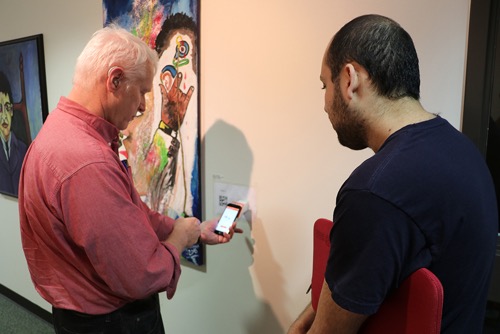App will provide access to art for deaf, hard-of-hearing people and others with disabilities.
Art lovers who are deaf or hard-of-hearing soon will have access to a deeper, richer museum experience, thanks to Rochester Institute of Technology’s National Technical Institute for the Deaf. The college is launching a mobile app to be used in its Dyer Arts Center that provides content in various forms, including video in American Sign Language, transcripts and audio and visual descriptions. The app was developed by members of RIT/NTID’s Center on Access Technology in cooperation with Dyer personnel and deaf and hard-of-hearing students from two of RIT’s other colleges: B. Thomas Golisano College of Computing and Information Sciences and the College of Imaging Arts and Sciences.

RIT/NTID faculty member Joseph Stanislaw, left, discusses the museum accessibility app with Musab Al-Smadi, a fourth-year software engineering student from Jordan. Credit: Mark Benjamin.
Wendy Dannels, a research faculty member in the Center on Access Technology, mentors several part-time and co-op student employees on this accessibility project. “It is a joy witnessing students building good character and self-confidence navigating this new technology,” she said.
The app will describe works on exhibit in three locations on the RIT campus: the NTID President’s Hallway, Rosica Hall and the arts center itself. There is a map showing the locations for the various exhibits contained within the app.
Information on the various art pieces can be accessed three ways: through a numbered system near each art piece that can be entered manually into the app, by taking a photo of a QR code, or though NFC, or Near Field Communication, a short-range wireless communication technology that allows two devices equipped with NFC technology to communicate with each other and share information as soon as they are close to one another.
Additionally, the app, powered by Museum Accessibility Intelligence, or MUSEAI™, contains an option that has been developed for use by those with vision issues, using a dark background, large font size, visual descriptor and audio description. Brian Trager, associate director of the Center on Access Technology, foresees a huge impact in end-users’ experiences using MUSEAI.
“MUSEAI is a unique platform for museum goers to enjoy and view additional content regarding an exhibit, artwork, historical facts and more,” Trager said. “What makes MUSEAI unique is that we designed accessibility to be the forefront of this technology to enable an enjoyable experience for everyone. MUSEAI serves as the cornerstone for accessibility, and the NTID Center on Access Technology aims to raise the bar higher for museums across the globe.”
Focus groups will provide feedback as perpetual testing continues to refine the app and its abilities.
“We’re very excited about testing and launching the Dyer Arts App,” said Dyer Arts Center Director Tabitha Jacques. “It will be especially helpful during NTID’s 50thAnniversary Reunion, June 28–July 1, when more than 2,500 people will be on campus – many of whom have never seen the Dyer Arts Center.”
RIT/NTID is home to one of the largest permanent collections of works by deaf and hard-of-hearing artists in the world.
About Rochester Institute of Technology
Rochester Institute of Technology is home to leading creators, entrepreneurs, innovators and researchers. Founded in 1829, RIT enrolls about 19,000 students in more than 200 career-oriented and professional programs, making it among the largest private universities in the U.S.
The university is internationally recognized and ranked for academic leadership in business, computing, engineering, imaging science, liberal arts, sustainability, and fine and applied arts. RIT also offers unparalleled support services for deaf and hard-of-hearing students. The cooperative education program is one of the oldest and largest in the nation. Global partnerships include campuses in China, Croatia, Dubai and Kosovo. For news, photos and videos, go to www.rit.edu/news.

